Menu

Did you know that 84 Agricultural Regulatory Inspection Officers have been hired in England? They will be doing more farm inspections. So, farmers must get ready for these checks. It’s important to follow the latest environmental rules closely. The Environment Agency (EA) wants more details, like slurry storage sizes and effluent tank capacities.
It’s crucial for farmers to talk to the EA about Slurry, Silage, and Agricultural Fuel Oil (SSAFO) rules. This conversation could help farmers see how strong the EA’s evidence is. It may also help them meet rules better and lower the chance of more severe actions. Farmers should check their insurance to make sure it covers legal and cleanup costs. This can help them be more ready for inspections.
Most EA checks are just to make sure farms are following the rules. They usually don’t lead to big problems. But, if they find issues, farmers might be asked to attend a PACE interview. Getting legal advice early can be a big help. It might keep farmers from getting into more trouble. And it could make the environmental audit of their farms go more smoothly.
Farms should use many strategies to be ready for inspections. They can learn from resources like the FDA’s ‘Guide to Produce Farm Investigations’ and Good Agricultural Practices. These guides are key for being fully prepared. They help ensure that the produce is safe. This way, products are kept safe from unsanitary growing or processing conditions. Therefore, they won’t be allowed to go into commerce across states.
On farms, environmental checks fall into two main groups. There are routine checks to make sure farms meet set standards. Then, there are special checks when contamination is suspected. These are vital to keep farming safe, limit health risks from germs, and encourage eco-friendly farm work.
Firstly, let’s look at the say these checks work. They are like a routine health check for farms, focusing on following the right rules. Even though some farm products aren’t checked on, farmers must still meet general standards. This keeps farms running in a safe and eco-friendly way.
Now, let’s explore what happens after a contamination scare. If food sickness is linked back to a farm, a deep investigation begins. The goal is to find out how germs got into the food. Expert teams use science to trace these germs, check how risky they are, and then update safety rules. This is crucial for checking the health of our countryside.
| Law | Enactment Year | Focus Area |
|---|---|---|
| The Clean Air Act (CAA) | 1963 | Air emissions from stationary and mobile sources |
| The Clean Water Act (CWA) | 1972 | Water quality standards |
| The Comprehensive Environmental Response, Compensation, and Liability Act (CERCLA) | 1980 | Hazardous waste sites |
| The Endangered Species Act (ESA) | 1973 | Protection of endangered species |
| The Resource Conservation and Recovery Act (RCRA) | 1976 | Disposal of solid and hazardous waste |
| The Safe Drinking Water Act (SDWA) | 1974 | Quality of drinking water |
| The Oil Pollution Act (OPA) | 1990 | Prevent oil spills |
Environmental inspections on farms are important for many reasons. They make sure that farming meets set rules and keeps the public safe. These checks help lower the risk of food poisoning. And, they help people feel confident about the food they eat.
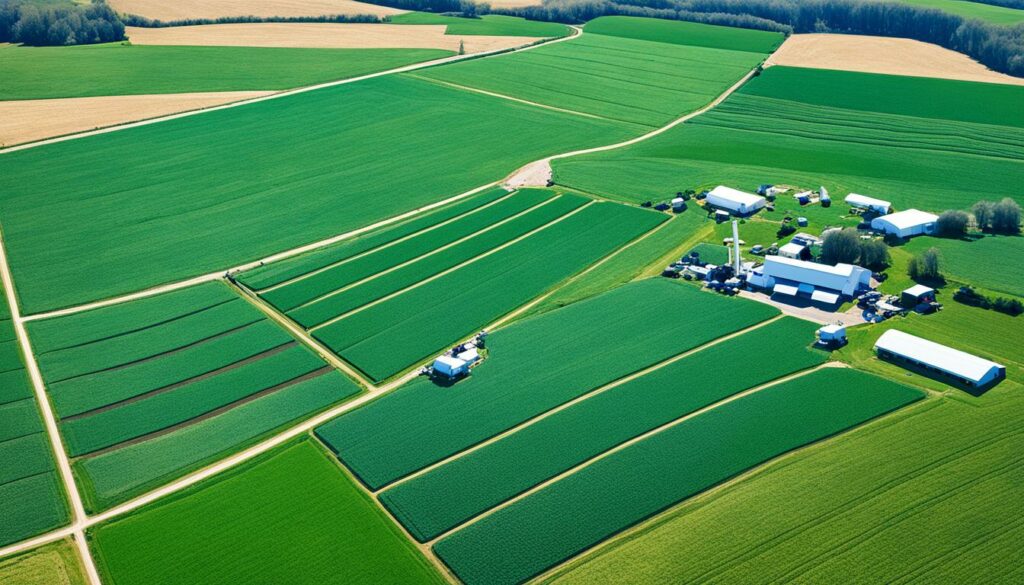
Farm environmental checks focus on sticking to the rules. The European Commission says these checks are key for following European environmental laws. They look at a farm’s impact on the environment and its ways of working.
This includes checking the farm’s air and water, how it deals with dangerous waste, and its water discharges. Using Environmental Management Systems helps farms to check they’re doing things right. This makes the whole process easier and more accurate.
These checks are also about keeping the public safe. They aim to stop illnesses caused by dirty food. By checking the source of any harmful germs, inspections make sure food is safe to eat. They help decide if some food products should be allowed in or kept out of the country.
Carrying out a detailed review of farms and the surrounding areas helps set rules to make food safer. Using digital tools makes these checks quicker and more effective. This means problems can be found and fixed fast, protecting people’s health.
| Inspection Aspect | Details |
|---|---|
| Air & Water Quality | Ensuring the farm’s air and water resources meet environmental standards. |
| Hazardous Waste Management | Managing and disposing of hazardous substances safely. |
| Water Discharges | Monitoring and controlling water discharges to prevent contamination. |
Getting ready for environmental inspections involves putting together a great team. This team’s job is to check if your farm follows the rules and the Produce Safety Rule. Inspections can take 2-4 hours, so having the right people is key.
The lead investigator, usually from the FDA, is very important. They look at the whole inspection and make sure the team works well together. The lead checks everything, like water sources and soil tests. They can also suggest changes if a farm isn’t following the rules, which helps keep everyone safe.
Your team should have these experts:
Getting ready for inspections means keeping a lot of records. Inspectors will look at how well your team is trained, if you follow safety rules, and if everything is kept clean. Passing these checks is very important for farms in California.
Picking the right people for your team is crucial. They will check everything from water use to how clean things are. This helps make sure your farm meets all the rules.
Farm environmental inspections planning is key for a successful check. You need to plan every detail and manage the farm inspection logistics smoothly. It’s important to have the right strategies in place for a good plan and to handle all the details well.
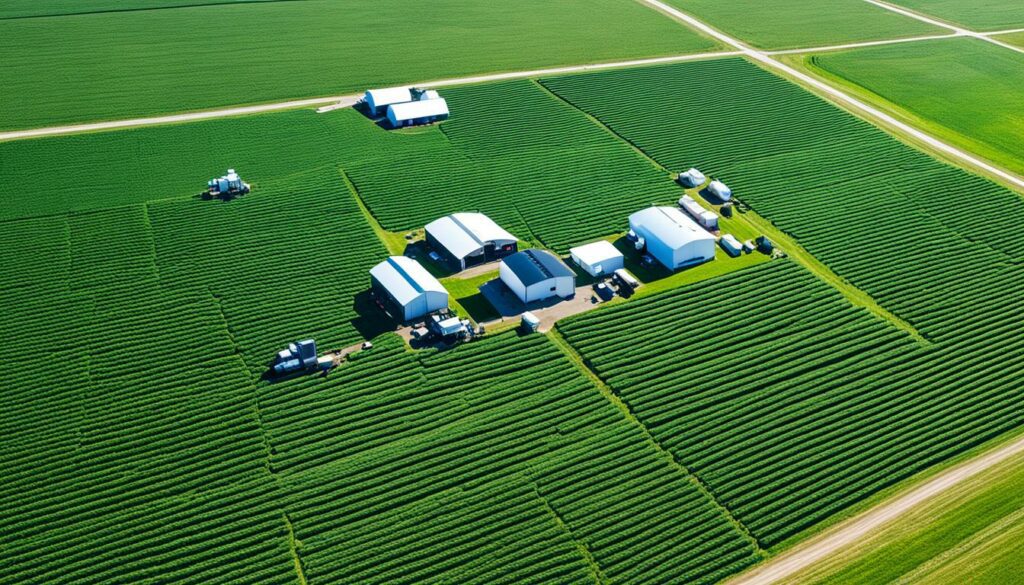
Start by making a detailed schedule. Have calls before and after the visit to make sure everyone knows the plan. It’s crucial that each person knows their role. For example, the core investigator leads the inspection, with experts in different areas focusing on their part. Before the visit, it’s important to have a meeting to clarify roles for a smooth operation.
Handling farm inspection logistics is crucial too. This includes sorting out where everyone will stay and how they’ll get there. Also, it’s important to get any needed equipment to the site without any trouble. Talking with local officials helps make everything smoother. Here’s a table to help keep track of what needs to be done:
| Logistics Checklist | Details |
|---|---|
| Travel Arrangements | Flight bookings, car rentals, and lodging. |
| Equipment Transportation | Ensure all inspection and testing equipment are ready and transported safely. |
| Team Coordination | Pre-trip briefings, role assignments, and timelines. |
| Local Liaison | Coordinate with local government agencies for facilitation. |
| Post-Trip Debriefing | Review findings and prepare initial reports within two weeks. |
For environmental inspections, the right farm inspection tools are key. You’ll need sampling devices, testing kits, and protective gear. This helps with careful and accurate checks of the environment.
First, you want sampling equipment. Get soil probes, water bottles for samples, and leaf kits. These let you check the farm thoroughly to spot any pollution. Also, have testing kits ready. These can test for germs or chemicals quickly.
| Essential Equipment | Function |
|---|---|
| Soil Probes | Collect soil samples to test for contaminants and nutrient levels |
| Water Sampling Bottles | Gather water samples for microbial and chemical testing |
| Leaf Sampling Kits | Analyse plant tissue for disease and contaminant exposure |
| Rapid Test Kits | Immediate detection of pathogens and pollutants in the environment |
| Protective Gear | Ensure safety and contamination prevention during inspections |
It’s vital to work with labs too. They help you get what you need and check samples fast. This is key for spotting risks and fixing problems.
Also, build a team with different experts like microbiologists. This gives you a thorough check. It makes sure what you find meets rules and is right.
Make a checklist and make sure all tools are ready. This step makes the inspection go smoother. It’s how you keep up with rules and manage any issues well.
Getting the farm layout right for inspection is key. Detailed maps are vital for showing crucial areas. They help plan the best way to go through the farm, making sure everything gets checked.
Setting up the farm layout for inspection is very important. These maps show the farm’s details, like where the most risks may be. Doing this prepares for a better check by the inspectors, improving their work a lot.

Efficient farm inspection mapping means marking essential zones. Places like fields, water spots, and where waste goes should stand out. This method ensures a deep examination without missing important spots.
The second edition of NEPA’s suggestions from December 2004 highlights how important detailed maps are. It talks about protecting species and the environment. It shows why clear documentation of farm layouts is crucial.
| Criteria | Details |
|---|---|
| Environmental Impacts | Guidance on biological impacts, cumulative impacts |
| Regulatory Compliance | Clean Air Act conformity, Floodplain Environmental Review |
| Historical Preservation | Includes historic preservation requirements |
DOE’s NEPA website offers vital info on making farm layouts right. It includes laws and advice to follow. Sticking to these rules makes for a smooth and accurate inspection.
Good water management ensures that food remains safe on farms. It also helps farms meet rules, like those from the FDA about water use. The rules cover checking water quality, how to treat water, and keeping records. They aim to stop fruit and veg from getting sickening germs. So, using the right methods to check where farm water comes from is very important.
Farmers first need to know the water table’s depth and if the area can get too wet. They check their water systems at the start of growing every year to keep water safe. If the water isn’t safe, they have to treat it before using it.
The FDA also sets clear rules about how to test water quality. They focus on water that directly touches crops or is used in farming. They use a step-by-step method to check water that could be dirty. This helps find and fix water problems fast.
Farmers need to follow FDA advice to keep farm water clean. If water is not safe, they can’t use it. They check water often and may use chemicals to clean it. They must also make sure they follow all EPA rules if using such treatments.
Following these rules helps farms avoid water problems. It also means sometimes farms can use not-so-perfect water on crops. This is if they wait enough time before they harvest. Using these strategies, farms can reduce the chances of spreading food-related illnesses through water.
The safe handling of manure and biosolids is central to meeting regulations on farms. It involves using the right manure management strategies and following strict rules. This helps lower the chance of spreading diseases, protecting the public. With more illnesses linked to fresh food recently, handling these materials correctly is more critical than ever.
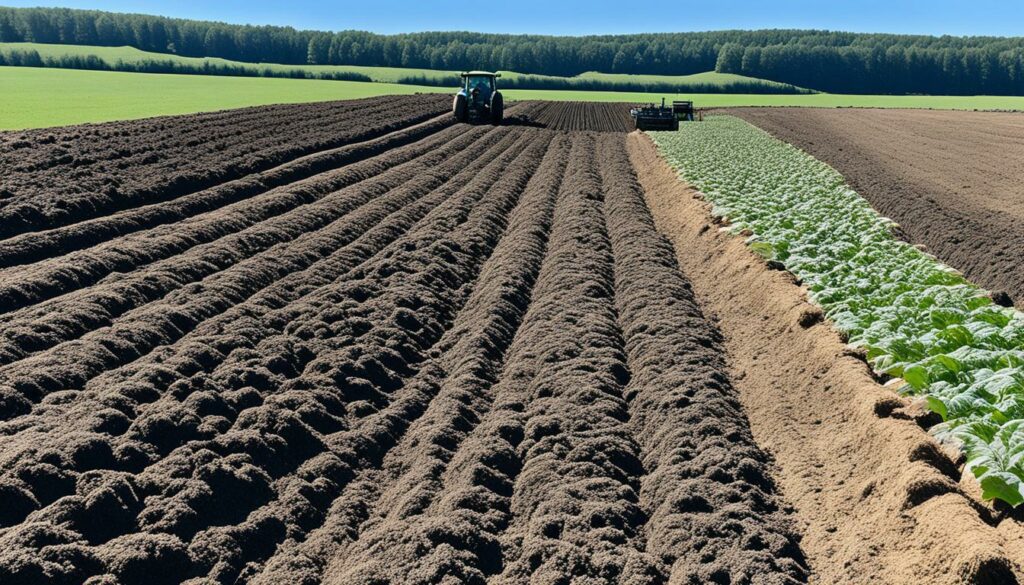
Farms need to have solid manure management strategies to lower risks. They should store, treat, and spread manure properly. Composting is a great way to cut down on harmful germs. Manure should go on fields when there’s little chance of it getting into the crops. Keeping good records and checking regularly helps show everything is being done right.
For farms that use treated sewage sludge (biosolids), following biosolids regulations is a must. These rules cover how to handle, treat, and spread biosolids to keep the environment and people safe. It’s important to know the latest guidelines from the EPA and FDA. Keeping records and training staff regularly are key in staying compliant with biosolids regulations.
Keeping workers healthy and clean on farms is very important. The Food Safety Modernization Act (FSMA) says farms must have good health rules for workers. This helps reduce the risk of dirt getting into the food and makes farms cleaner.
Farms need strict rules for worker health. Workers learn how to stay clean and stop spreading germs. They must wash their hands well, use sanitizers, and wear clean clothes.
It’s also key that farms have clean places for workers to take care of their health. There should be spotless toilets, enough places to wash hands, and first aid readily available. Having these helps stop diseases from spreading, making work safer.
Good farm hygiene stops the food from getting dirty. Workers must have health checks. Those who are sick should not touch the food. This is part of making sure the produce is safe, as the Produce Safety Rule (PSR) highlights.
Following these rules is not only about doing what the law says. It’s also a way to keep people healthy. For example, since 2019, there have been special checks in Massachusetts. They look at water quality, soil health, and how workers and their hygiene affect food safety. Doing things right protects farmworkers and those who eat the food.
In the end, making sure farm workers keep healthy and clean is crucial. It helps farms meet the standards of the Food Safety Modernization Act. Plus, it keeps the workers and the food safe.
Keeping farm facilities clean is vital. It helps meet hygiene standards and make sure farms are safe. The FSMA requires farms to keep things clean. This is to lower the chance of people getting sick from their food.
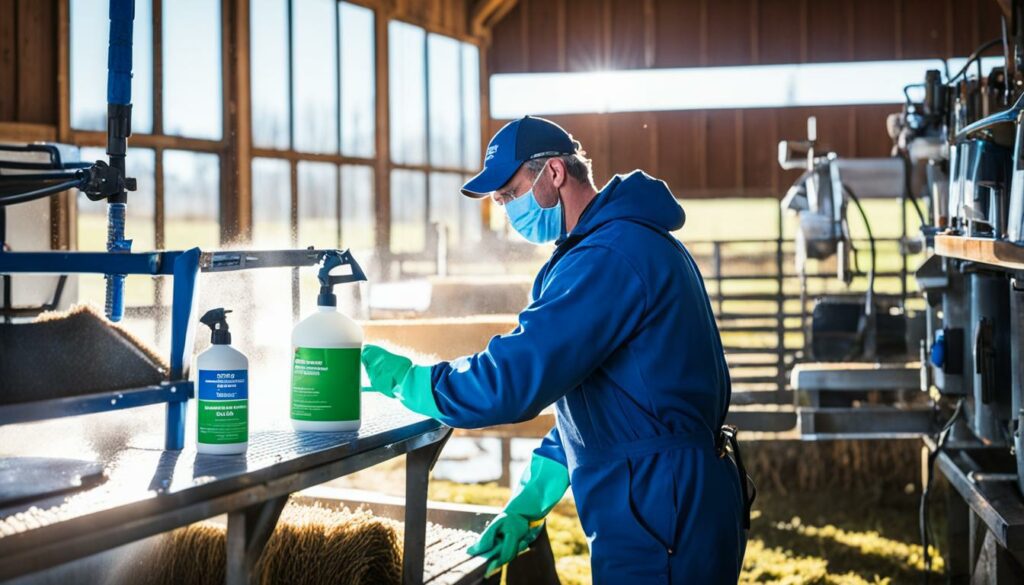
The PSR says farms must have clean toilets and places to wash hands. This is especially important for produce farms. Keeping these places clean stops harmful germs from getting on the food.
It’s key to clean farm spaces often. Following Good Agricultural Practices means regular cleaning. This includes places that grow, gather, pack, or store food. Toilets and handwashing spots must be tidied daily to keep germs away. Details on cleaning can be found in the Sanitary Facilities Guidelines.
Looking after key facilities is a must for farm hygiene. Under the PSR, special attention is needed for:
Properly managing these areas helps stop germ spreading. It also meets federal, state, and local safety laws.
| Facility | Frequency of Cleaning | Compliance Measures |
|---|---|---|
| Restrooms | Daily | Ensure soap, water, and disposable towels are available |
| Handwashing Stations | Daily | Sanitise surfaces to prevent microbial contamination |
| Drainage Systems | Weekly | Verify that drainage routes are unobstructed |
| Sewage Disposal | Monthly | Inspect and repair any leaks or damage promptly |
Sticking to cleaning schedules keeps sanitation good. This helps farms stay clean and safe for everyone.
Implementing effective farm field sanitation procedures is crucial for reducing risks from germs. “Food Safety on the Farm” underlines how maintaining high cleaning standards lowers the chance of contamination.
The Food Safety Modernization Act (FSMA) requires farms to follow certain rules since January 2011. The rules are designed to meet Good Agricultural Practices (GAPs). Florida’s mango and tomato farms, for example, must keep their facilities very clean. This includes making sure water systems, toilets, and cleaning areas are safe to use. Doing this helps keep food safe from sickness-causing bacteria.
Cleaning the farm environment is critical for keeping workers and customers safe from diseases. Everyone at the farm, including visitors and staff, should know about keeping things clean. Water used on crops must also be clean to avoid spreading germs.
The use of animal manure is a big health risk if not handled correctly. It can make the soil and the crops on it dangerous. To counter this, composting and safe pesticide use are vital farm cleaning practices.
Before the harvest, farms must check for possible safety dangers. Doing this helps stop contamination problems from water, soil, or other sources. Treating seeds and cleaning produce with sanitizing agents also helps avoid sickness.
By taking farm cleaning seriously, farmers can produce safer food. They also meet important rules and build trust with customers. Following FSMA and PSR is key for a farm to operate well and last.
It’s vital for farms to follow rules in how they handle and pack their products. This is even more important now because illnesses from fresh foods are rising. By focusing on making sure produce is handled the right way, most risks can be avoided. This keeps food safe for everyone.
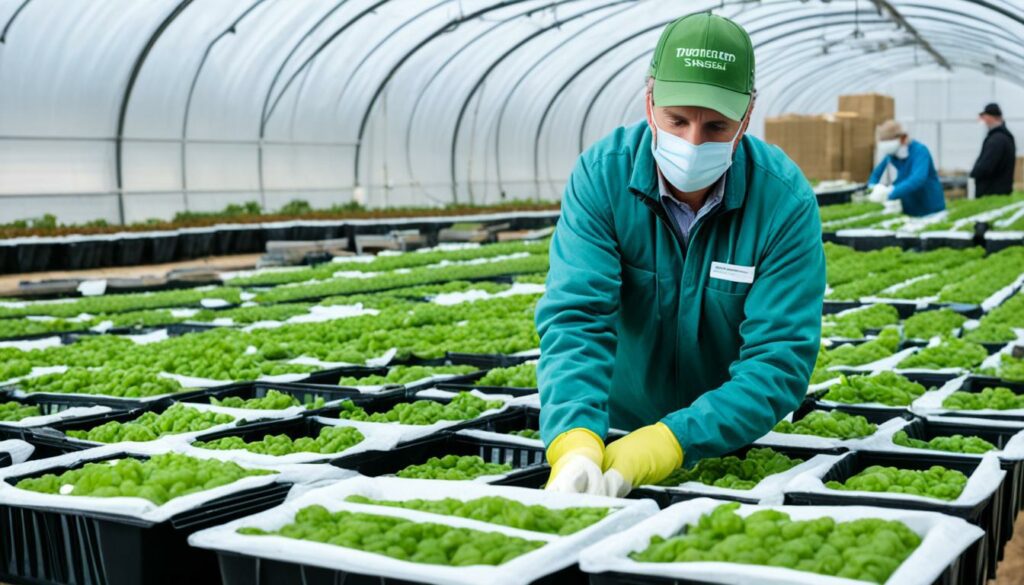
Handling fresh produce must start by being very clean. This means washing hands often and using clean tools. It’s also important to keep the work areas tidy. These steps help keep the produce clean and safe from germs.
To keep food from getting dirty, clean containers are a must when packing. It’s also key to keep produce from different places apart to stop the spread of germs. Also, checking the packing areas regularly and keeping good records help find and fix problems fast.
The FDA looks into farms’ safety methods to prevent germs from getting on the produce. They watch how things are done and make sure any issues get fixed. Doing this means the food meets high safety standards. It’s good for everyone.
By paying a lot of attention to how produce is handled and keeping it from getting dirty, risks can be lowered. This is important not just for rules but for keeping food safe. It protects people and the farms too.
Getting farm samples and their analysis just right is very important. It helps farms meet standards and keeps people healthy. Good methods give us key facts about farm conditions and find any contamination sources.
Inspectors collect samples carefully to make sure they’re accurate. They take 3-5 pounds of fresh fruits and veg but just 1 pound of berries. Farm sample collection must include certain details:
Keeping samples safe from start to finish is key. Inspectors wear gloves, seal samples correctly, and label them well. They must follow strict shipping rules. Fresh and frozen samples need to be kept cold in shipping. Processed foods can be at room temperature if they’re not opened until delivered.
After collecting samples, they’re checked for any bad stuff or wrong practices on the farm. The results are carefully noted and shared. The checks cover things like:
Telling the results to those involved is crucial. It helps with rules and makes farms safer. Good reporting protects public health and farms’ future.
In agriculture, it’s crucial to have a good on-farm traceability system. This ensures produce is safe and meets rules. Farms track their goods from the ground to customers. Robust traceability also helps farms follow rules and boosts their image for safety and quality.
Traceability starts with good records. Farms must accurately document everything, from pesticide use to keeping pests away. There are many dangers, like E. coli, too much pesticide, and even metal in the food. Records help farms find and solve problems fast, keeping customers safe and trusting their produce.
A good system has several parts. Farms need to follow precise rules and update safety plans. They should use lot codes to track products easily. Also, getting certified and joining food safety schemes can make tracking more effective.
Ensuring clean water, worker health, and sanitation is vital. These steps reduce the chances of food becoming unsafe. Farms making over $500,000 yearly must follow strict rules under the FSMA Produce Safety Rule. Training is available to help farmers improve their safety plans.
The aim is to check that farms follow the rules. This stops the sale of dirty produce. It helps keep us safe.
These checks look at how farms use their land. They make sure the land use is safe for everyone. The goal is to protect nature and the people.
An audit checks how farms handle their business. It looks at everything from the water they use to the food they sell. The aim is to meet eco and legal rules.
Regular checks stop problems before they happen. But, if there’s a sickness scare, the checks are intense. They look for what went wrong to fix it. This is called an investigation.
This evaluation checks if farming hurts the earth. It makes sure we farm in ways that last a long time. The goal is a healthy planet that feeds everyone.
The lead organises the check-up team. They make sure all steps are done right. This is how they do their job well.
To work well, there must be a detailed plan. Everyone must know their job. Talking before and after the visit helps. So does sorting out who does what and how to get there.
Tools for testing and protecting yourself are a must. You also need a good map of the farm. This helps show where to go and what to check.
Right maps show the main spots and paths to check. They are a guide for looking around. And they help keep track of what’s safe and what’s not.
Checking water for danger, stopping risks, and knowing about water below the ground is key. This keeps the water safe for all to use.
Follow the rules in dealing with manure and waste. This means stopping bugs and keeping the environment clean.
Farms need health rules, space for first-aid, and training. This makes sure workers stay clean and safe.
Clean places stop bad stuff from spreading. So, making sure toilets and washing areas are tidy and work well is very important.
Throwing waste away safely, managing water that flows from fields, and farming cleanly stop sickness. These are top ways to keep food safe.
To keep food safe, farms must be clean, handle food well, and wash often. This stops harmful bugs from spreading.
Choosing the right samples, testing them carefully, and writing down what you find is key. This makes sure farms meet the rules.
Traceability shows where food comes from. This helps fix problems and follow rules. It’s a record of farming practices and care.